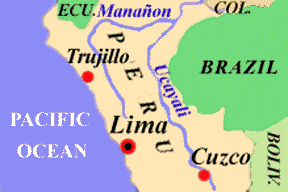|
When Francisco Pizarro toppled the Inca monarchy in the mid 1530’s with
a few hundred Spanish adventurers, the popular culture supporting the Inca
rulers of the Peruvian Andes sank into relative obscurity. While there are
many accounts of the subsequent colonial period, and numerous architectural
ruins at Inca sites from Cuzco to Machu Pichu, many aspects of the lives
of the pre-Spanish Incan people - a major Native American civilization -
have been little known from the period just before the Conquest.
Now this is changing, with the discovery of thousands of Inca mummies near
Lima (fig.1) from the period of about AD 1470-1535. About 2,200 mummy bundles of
 Inca men, women, and children, many in an excellent state of preservation,
have been excavated at a shantytown named Tupac Amuru built over the Inca
cemetery site of Puruchuco- Huaquerones, at the base of desert foothills
on the eastern edge of the Peruvian capital. Inca men, women, and children, many in an excellent state of preservation,
have been excavated at a shantytown named Tupac Amuru built over the Inca
cemetery site of Puruchuco- Huaquerones, at the base of desert foothills
on the eastern edge of the Peruvian capital. Fig.1: Map of region of Lima, Peru.
The mummies
were revealed largely by accident during the past decade, as the suburb of
Tupac Amuru (named after the last Inca monarch, killed by Spaniards in 1572)
grew from settlers fleeing 1980s guerilla warfare in the mountains. Sewage
from the new settlement disturbed the sleeping city of the dead just underground,
well preserved until then by the typically dry, sandy conditions of coastal
Peru. Salvage excavation led by archaeologist Guillermo Cock of Peru's National
Institute of Culture, and partly funded by the National Geographic Society's
Committee for Research and Exploration, converted streets into excavation
trenches, to recover this unparalleled sample of the late 15th-early 16th
century Inca population. Overall cemetary size at Puruchuco is estimated
by Cock at about 10,000 bundles containing 15,000 people, making it one of
the two largest Peruvian mummy burial sites known, and the largest
for the Late Horizon, Inca period. An estimated 60 percent of the burials
remain undisturbed.
The excavations recovered over 1,200 burials in ten weeks last year, with
Tupac Amaru residents assisting at the emergency dig. The archaeologists
have been rewarded with a database that, quite literally, will rewrite our
understanding of Incan culture. The several hundred Inca mummies examined
so far represent two to three generations and a variety of social classes
over a period of 60-75 years who died from a variety of causes ranging from
malnutrition, anemia, and probable tuberculosis, to trauma and human sacrifice.
The dead (many with hair, skin, and eyes still intact) were wrapped in
cocoon-like bundles of raw cotton and woven textiles holding as many as seven
individuals, some with both adults and children probably representing families. The bodies were dried or embalmed by being wrapped in fabric and buried upright
in pits filled with crushed pottery sherds and gravel, which rapidly leached
out the moisture. Some 45 per cent of the buried individuals were children
under 12 years old. About 40 of the larger mummy bundles, meanwhile, were
topped with false heads (some with wigs) known to have been used for burials
of Inca elite. Only one example of such “falsas cabezas” has been
previously excavated. Many of the bundles contained artifacts, personal items,
food, and utensils which were probably meant for use in the afterlife. One
person, nicknamed “the cotton king,” holding a small child, was
wrapped in over 300 lbs of raw cotton, along with a well preserved sack of
coca leaves and brick of quicklime - a combination also much used today
as a stimulant. The richest source of elite burials occurred beneath the
town schoolyard.
The Inca empire, which spread north from Cuzco in 1438 to dominate the Andean
region by 1450, has been considered an elite caste who took over local
populations and imposed their imperial ideology on them. But the Puruchuco
burial artifacts show a mixture of Inca and local styles, suggesting the
creation of a unique synthesis around Lima. Given a relatively high proportion
of elite burials mixed in with more modest mummy bundles, Cock believes there
is evidence of a large Inca palace near the cemetery, and a perhaps as many
as ten recognized Incan social statuses among the buried population. The
well-preserved bodies will also allow detailed analysis of the diet, general
health, and causes of death of the population, as well as their genetic
relationships. Along with an estimated 50-60,000 artifacts from the
mummy bundles, the Puruchuco burials represent a late Precolumbian time capsule
of incredible scientific value. Mummies and artifacts will eventually be
displayed in a Puruchuco museum.
References: National Geographic. 2002. http://www.nationalgeographic.com/tv/channel/ mummy/index.htm
.
This article appears in the Recent Finds in Archaeology section of Vol.3, No.2 of Athena
Review.
.
|
|